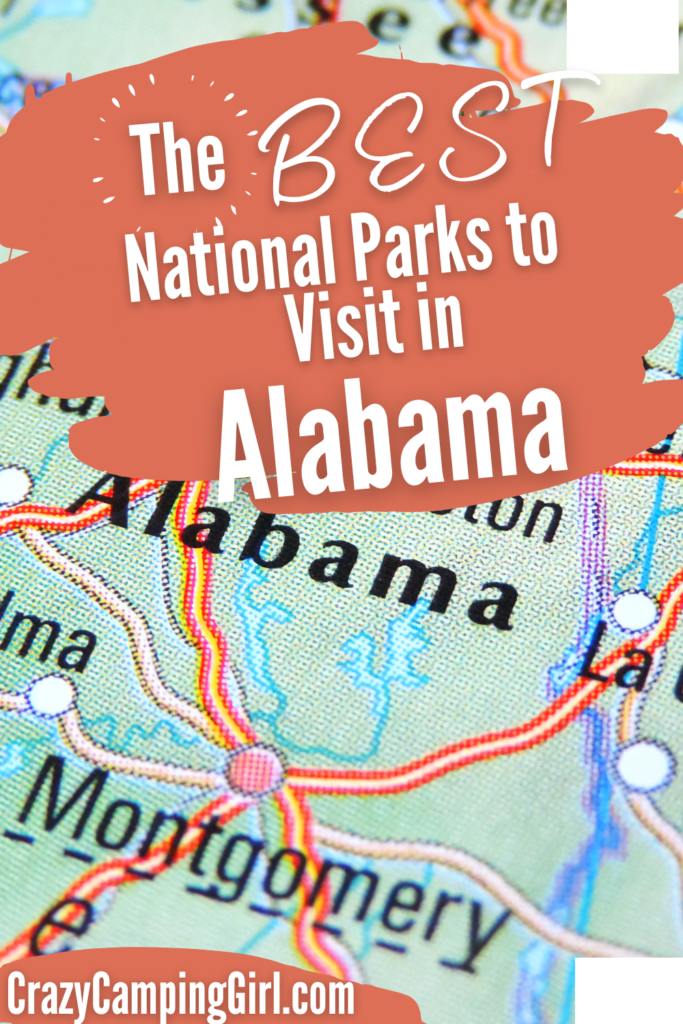
The Best National Parks in Alabama to Check Out
We may earn money or products from the companies mentioned in this post.
Southern charm and hospitality welcome all visitors to Alabama with open arms. Travelers can fly into the state through two international airports – located in Birmingham or Huntsville; or by using the regional airports in Dothan, Montgomery, Mobile, and Muscle Shoals. For football fans, Tuscaloosa even provides a municipal airport.

The average temperatures in the state are influenced greatly by the southern location and the Gulf winds. The lowest average temperature is 39 degrees (F) occurring in January while the highest average temperature is 91 degrees (F) in July. The majority of the state receives precipitation of 54 to 58 inches per year – usually of rain.
Very little snow falls in Alabama in a given year. A minute area of the state, near the coast, receives over 66 inches of rain annually. During the summer months, a visitor can expect hot temperatures and high humidity throughout much of the state.
Alabama is home to a lot of historic sites, natural wonders, miles of trails and has some of the best state parks and national parks perfect for outdoor recreation is you decide to visit the great state. So here is a list of national parks that you should consider visiting on your next vacation.

–>Camp recipes – kid-approved! – 2 pages
–>Nature scavenger hunt – get outside into nature!
–>Paper games for that possibly rainy day or long car trip – 3 pages. Just click on the image to see it in our Etsy shop!
The Best National Parks To Visit In Alabama
Horseshoe Bend National Park, located near Dadeville Alabama, is a very popular destination and is one of four of the U.S. National Park Service’s dedicated “War of 1812” national parks. Deriving its name from the Tallapoosa River, which is shaped like a horseshoe, the park is a solemn commemoration of the Creek War and the War of 1812.
Filled with natural beauty and home to thousands of plant species and hundreds of animal species, Horseshoe Bend boasts historic scenic trails, historical sites, beautiful waterfalls, scenic views, biking trails, battlefields, and a Creek Indian village site.
Nestled among the scene of a battle that helped propel General Andrew Jackson to the presidency is an educational visitor’s center that only begins to tell the story of the events that occurred here. For the rest of the story, visitors need only to trek the 2.8 miles of trail that descriptively unfold the battle in storybook fashion.

The History Of Horseshoe Bend National Military Park
In the early 1800s conspirators began a rumor that Creek Indians, who were friendly to settlers in the area, had begun fighting with them. The information was erroneous and the local Creek Indian tribe set out, along with the U.S. military and Cherokee allies, on a hunt to prosecute the conspirators who started it all. A Declaration of War was announced following the Red Stick Indian’s hostility and attack on U.S. settlers in the area.
Around 600 Cherokee and Creek Indian, allies helped General Andrew Jackson and his 700 infantrymen surround the Redsticks at Horseshoe Bend as the battle ensued. Back then, Native Americans knew the area as “Cholocco Litabixee”, or Horse’s Flatfoot.
Horseshoe Bend National Park is one of the battlefields that are responsible for Andrew Jackson’s fame and, later, presidential election. One year into his presidency, Jackson signed the Indian Removal Bill, forcing the Creek and other tribes in this area to move to Oklahoma on a path that is now known as the “Trail of Tears”, a term coined by the Cherokee.

Tuskegee Airmen National Historic Site
The legend of the 332nd Fighter Group of the U.S. Army Air Corps is one of the great stories of American history. The service of the nearly 1,000 young African-American men who enlisted and trained at Tuskegee University between 1940 and 1946 was one of the triumphs of American ideals over ignorance and racism that paved the way for an integrated military. The proud history of these pioneers lives on in the 332nd Air Expeditionary Group of the Ninth Air Force.
Although civil aviation grew steadily from its beginnings at Kittyhawk through the 1920s, military aviation was dismissed as a passing fad after World War I. Despite the warnings of Col. Billy Mitchell throughout the late 1920s and early ’30s, military aviation consisted largely of dirigible development. Civil aviation, however, flourished, with innovations in agricultural uses and entertainment.

History
Throughout America’s history, African Americans have served honorably in its military, very often in a support role. Beginning in the War of 1812, however, units like the Louisiana Battalion of Free Men of Color, the Buffalo Soldiers, the 9th U.S. Cavalry, and the 369th Infantry Regiment distinguished themselves, often taking the lead in battle.
Many African Americans also served in the U.S. Navy throughout its history. Throughout American history, though, African Americans who served in battle were segregated into separate units and, when the U.S. Army Air Corps was founded during World War I, no training facilities existed for African Americans.
Natchez Trace Parkway Is The Perfect Place To See
Though not as famous as the National Road, the Natchez Trace national scenic trail was vital to the farmers and tradesmen in the early nineteenth century. The Natchez Trace is a path that runs about 500 miles from Natchez, Mississippi to Nashville, Tennessee. It also links the Cumberland, Tennessee river, and Mississippi Rivers.

The Trace national historic landmark has a long history, stretching many hundreds of years. American bison, more commonly known as buffalo, were among the first “trailblazers.” The great lumbering beasts went north to find the salt licks in the Nashville area, trampling down the undergrowth in the process.
Later, Native American Indians followed, until it was wide enough for a man and horse to travel on—remarkable for the time. A good part of the Trace goes through today’s state of Alabama. In historic times the Trace went through the lands of the Choctaw and Chickasaw.
It was said that Hernando De Soto, the Spanish conquistador, followed part of the trace in the 16th century, and General—later President– Andrew Jackson used the Trace to get to New Orleans during the War of 1812.
Thomas Jefferson And The Old Natchez Trace
Around 1800 President Thomas Jefferson became uneasy at the increasing influence of the French in the Mississippi River region, an influence that would culminate in Napoleon’s seizure of Louisiana Territory from the Spanish European settlers.
Jefferson felt that the Natchez Trace—made a post road, improved and widened—would check French ambitions by establishing an American “path” into the Mississippi. After the Louisiana Purchase in 1803, the French danger receded, but American farmers still needed to go down the Mississippi with their crops.

The U.S. Army began work on the Trace in 1801, and by 1809 it was good enough to allow horse and wagon traffic. Farmers in Kentucky and Tennessee floated their produce down the river on flatboats to sell and transship in New Orleans. In those early years, The Trace was mainly used by farmers and traders going north, towards home. Flatboats were “one-way” transportation, depending on the Mississippi current to go downriver. After selling their produce, many farmers would then walk home via the trace.
Selma To Montgomery March Byway Is A Great Place For A Scenic Drive
Reading about history in books is one thing, but to be able to take history out of the books and make it come to life, to walk in the places where history was made makes it real, not just words on paper and that is what you have a chance to do when you set out to explore off the beaten track and drive along the Selma to Montgomery March Byway.
The total trip is just over 54 miles and with all the stops, it will just take one day. A day that you will remember for all the days of your life. The byway is operated by the National Parks Service and you will stop and explore all the places you have heard about in the over forty years since Dr. Martin Luther King led one of the most famous marches in anyone’s history.
Before you begin to explore the Selma to Montgomery March Byway, get books from the library and let the children see what it was like back in 1965. It will make the trip more meaningful for them if they can connect what they are seeing, with the pictures from the past.

Take your time and don’t skip any of the sites. It is well worth spending the whole day.
Start at the day at The First (Colored) Baptist Church.
The Church itself speaks history. It was built in 1845 and if it could talk, it would tell you many stories from before and after the march.
The Brown Chapel
This is the spot where the march actually started. You probably will not be able to go inside, you will need to make an appointment.
National Voting Rights Museum and Institute
This one will take up most of your time, but do see it all. Get the whole picture. It is not something to hurry through.
Edmund Pettus Bridge
One of the most famous bridges in history. The original march was halted here on March 7th, but that did not stop the voting rights contingent. They got a court order permitting the march and on the 21st, they were able to go all the way to the State Capital.
City of St. Jude Historic District
Anyone who remembers the march, remembers the concert by such performers as Tony Bennet and Sammy Davis Jr. The grounds of the City of St. Jude Hospital are the place where the concert occurred. It was also the last campground for the marchers before they arrived at the capital

Alabama State Capitol Building
The end of the march and your journey. Climb the steps and stand where Dr. King made his famous “How Long, Not Long.” speech.
Like the Best National Parks in Alabama? Check out these articles:
- Tips for Cold Weather Camping
- Camping in Bad Weather: Tips for Staying Safe, Dry, and (Mostly) Sane
- Free Car Camping: Guide to the Best Spots
- Campfire Cooking With Kids: A Recipe for Learning, Laughing, and Lifetime Memories
- Best Camping Lighter: Top Picks for 2025